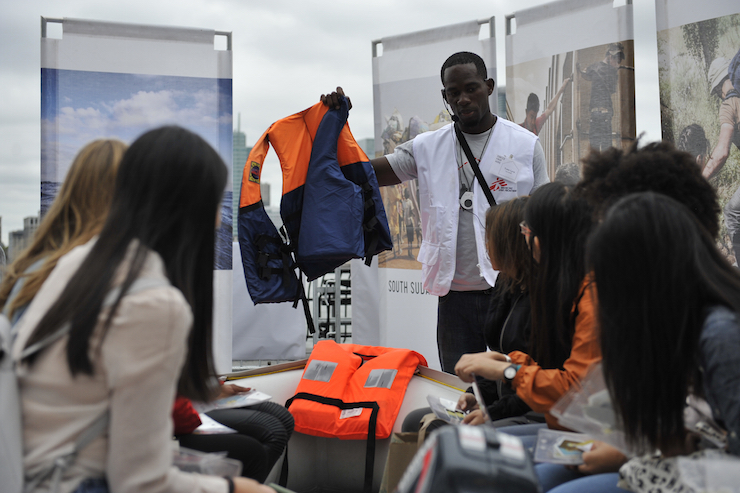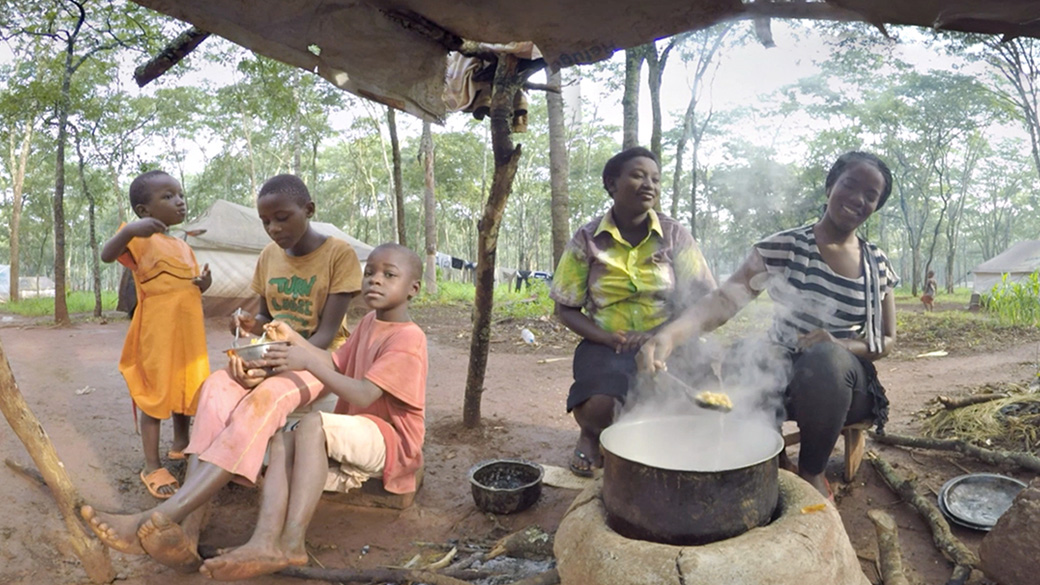How Doctors Without Borders and a VR studio built an immersive exhibit about refugee camps
Doctors Without Borders will be in Boston this weekend with an immersive outdoor exhibit called “Forced From Home” that promises to take visitors, using virtual reality, on a guided tour of refugee camps and informal settlements in Afghanistan, Burundi, Honduras, Syria and South Sudan.
The “Forced From Home” website currently has several 360 video clips from Tanzania, Mexico, Lebanon and Greece. The exhibit, which moves to Philadelphia and Pittsburgh next, will have exclusive stories not available online.
Storybench asked two of the project’s producers, Melissa Pracht, digital content editor at Doctors Without Borders, and Will McMaster, head of VR at Visualise, a virtual reality studio, where they drew inspiration for the project, how they pulled it off, and how virtual reality might help change the way people view migration and refugees.
How was this project envisioned?
Melissa Pracht: This exhibit was based on an older exhibit we ran many years ago called “Refugee Camp in the Heart of the City,” which was a tour not unlike this one, where people were given a fuller idea of what it means to be displaced like what to take with them and what to leave behind. The idea was to update that old tour with new technology and the way displacement has changed. People who are traveling on oceans, on trains, using Whatsapp and social media to communicate with families and smugglers. There’s just a lot more to talk about.
Where did you draw inspiration? The New York Times’ The Displaced was probably up there, right?
Pracht: Actually it was us and The New York Times that thought about it at the same time. But the UNHCR beat us both to it. Right now, they’re in the middle of a series of short VR pieces they’re making. They launched the project with [filmmaker] Chris Milk a couple of years ago. We really looked at what they had done, went and met with them, and were absolutely blown away by it.
What did you want users to get a sense of or feel?
Pracht: There was this moment when a woman looks right at the camera, and it feels so real, it sends chills down your body. It was an emotional response. That’s when it clicked for me. This is what we need to do. We need people to look at stories of displacement as stories of individual human beings, not an abstract thing like people invading a country. We needed a much more human way of looking at it. If anything is going to get that across, it could be VR.
What were biggest challenges to getting cameras and videographers out to each of the camps?
Pracht: That’s been a real adventure. We knew that we wanted to use VR and 360 early on. We had a team of three people go to each place. One VR cameraman, one audio engineer, and one producer. Synchronizing the audio was a challenge. We were used to working with DSLRs and framing shots. This was a totally different challenge. We had to figure out how to do interviews with none of us in the picture. We ended up working with a translator so they really understood what we wanted to get and the questions we wanted to ask. We’d have the translator conduct the interviews and we would all hide in the corner. In Tanzania, we were hiding behind a refugee tent.
What equipment did you use?
Will McMaster: The footage was shot with two different Gopro-based 360 rigs which we have customized to work with our own tripod and ambisonic audio recording system. Gopros were a good choice for this project because we were going into situations where the minimum amount of equipment was a requirement.
What kind of post-processing did you do?
McMaster: Post was done with a variety of different pieces of software. The initial 360 stitching was done with Autopano Video. Cleanup of stitches, patches, removal of equipment was done with Nuke. Editing was done in Premiere and color grading was done with Colorista. The amount of work done on post for this project is unprecedented in the VR industry, involving thousands of hours of work across our whole team. The finished footage for the project totaled nearly an hour, and we think the overall quality is extremely high.
Tell us about using a “clean plate” shot and any other tips you have for newbies to 360 video.
McMaster: Clean plating is the process doing a shot a number of times from the same position in order to remove elements which we don’t want. For example, during the interviews in the piece, our crew, the interviewer, etc. were all visible in the 360 shot. After the interview, we would clear everyone from the space to do the clean plate. Then we composite the clean plate over top of the areas where there is crew visible. The effect is seamless, though it’s challenging to manage changes in light, or other unexpected elements coming into the scene. Generally, for people shooting 360 video for the first time, I suggest that people focus on directing the scene so that there is one point of interest, and that point is easy for the viewer to follow. A mistake that many first-timers make is that they try to cram as many things as they can around the camera with the idea that to take full advantage of the 360 they need to fill every angle with something to look at. This actually has the effect of disassociating the viewer because they are unsure what to look at. It makes it harder to follow the story.
What were the largest challenges with producing the 360 docs?
McMaster: Many of the challenges shooting the 360 docs came from the difficulty of the environments themselves. It’s very difficult to get the shot you need when you have crowds of people in a refugee camp surrounding the camera, though this situation is completely understandable. On the shoot, despite massive heat, and rain at points, the equipment worked well, though in southern Mexico it was so hot that we could only run the cameras for 8 minutes before the overheated, which made doing interviews difficult. The biggest challenge of this project was the enormous amount of footage which had to be stitched, and the requirement for the highest possible quality. Many, many hours of overtime went into creating such high quality stitches and much of the work had to be done by hand.
What will the experience in Boston and other cities look like?
Pracht: The Forced from Home exhibit is going to be an interesting mix of using current, new technology and using hands-on material. You’ll go into a domed tent where you’ll see scenes from places around the world like Southern Mexico, South Sudan, Iraq, Lebanon and Tanzania. That will be a short 360 film and then after that you’ll go on a tour with an experienced MSF field worker telling you about different challenges facing people and different aspects of displacement. After that tour, you can go into the VR tent and watch any of these three VR documentaries on headsets.

What should students of 360 video know? What advice do you have for folks pitching and developing similar projects?
Pracht: Ideally, you’d be able to follow someone from their home, on their journey, to wherever they’re able to take shelter, to get the full experience. But we couldn’t do that. It’s dangerous. So we have to rely on people telling their story, about their life now, and their experiences beforehand. I don’t think we’ve realized the possibilities yet with VR. It’s just a matter of tinkering around with it. Just start experimenting. What has an effect on people? How does audio affect people’s experiences? I wish we had time to try out a lot of different things. This is all a learning experience. It’s an exciting time.





